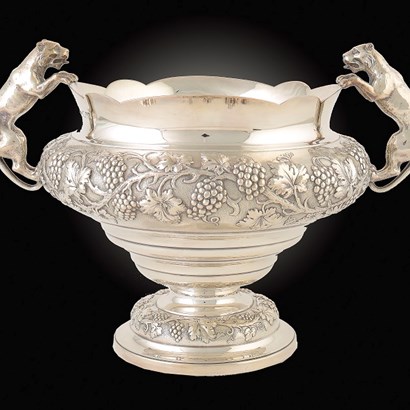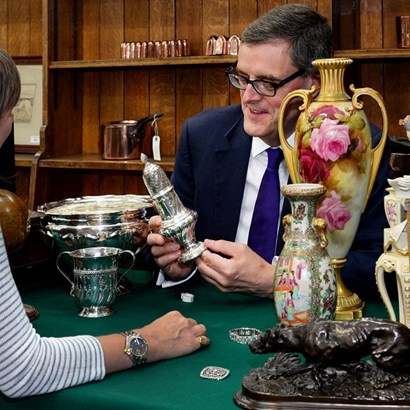Auction Insights
The Great 'She' Bible
Many people say they will ‘Swear on the Bible’ because holy texts of scripture is authoritative. That’s the point of it, but thanks to the printers, you shouldn’t believe all you read in old bibles.
I am often asked by visitors whether old bibles are collectors’ items. This is because the Good Book occupied so central a place in the family life of our ancestors, especially during the 19th century when the churches, chapels and synagogues were as full as some of the new churches that are springing up in Nottingham are today.
You might think one old bible looks pretty much like another but you’d be wrong. It is surprising how often a valuable edition turns up. Mellors & Kirk sold an example of the the Great ‘She’ Bible of 1613 last month for £6,000. It was a very good price for the Good Book, especially as it was incomplete. Its called ‘Great’ on account of its size – the pages were some 40cm tall – and was used for preaching and ‘She’ because the word mistakenly appears instead of ‘He’ at Ruth 3: 15. This example was technically the second issue of the most famous bible of all time, the King James or Authorised Version. The five years’ hard work from a special team of 54 translators set out to make “One principall good one, not just justly to be excepted against.” Historian T B Macaulay described it as “a book which, if everything else in our language should perish, would alone suffice to show the whole extent of its beauty and power.”
Despite all this it contains a truly shocking printer’s error. In one place the name of Judas appears instead of Jesus. This error was usually corrected at the time by a hastily pasted over slip of paper with Jesus’ name and it was still present in the copy we sold 404 years later!
The King James Bible is not alone in containing howlers such as these. Some are so startling one wonders whether they were deliberate, perhaps by some disgruntled compositor, or even more sinister hands were at work.
Ever since Johannes Gutenberg introduced printing to Europe, books have been littered with typos. The first English printed bible, Coverdale’s of 1535 is sometimes called the ‘Bug Bible’ because in psalm 91 we read “thou shall not nede to be afrayed for eny bugges by night.” in Middle English ‘bugge’ means a spector or ghost. If that is a forgivable oversight the next certainly is not. Around 1550 the “Wife-Beaters Bible” was published, containing a notorious footnote urging husbands of disobedient wives to “beate the fere of God into her heade.” Then there is the Breeches Bible, which is surprisingly common. The shocking appearance of so naughty a word was felt to be an inappropriate translation when ‘coverings’ should have been used instead for Adam and Eve’s donning of a strategically placed fig leaf.
Count yourself lucky if you find a copy of the ‘Wicked Bible’ printed in 1631. In it the omission of ‘not’ means we are also supposed to commit adultery! ‘Not’ surprisingly the copies were all recalled so they are extremely rare and the careless printer was fined £300. The absence of the same word was to blame a few years later as it is apparently the unrighteous who shall inherit the Kingdom of God.
The list seems endless and extends to the 20th century. The 18th century saw the appearance in 1716 of “sin on more” instead of “sin no more” in Jeremiah 31:34. John Baskett, a famous bible publisher excelled himself the following year with an edition that includes the parable of the vinegar instead of the vineyard. His so called ‘Vinegar Bible’ was littered with careless mistakes and it didn’t take long for one wit to describe it as a “Baskett-ful of errors”. A very good copy of it was in Lord Wardington’s collection that sold at Sotheby’s in 2006 for £6,600.
I’ve some sympathy with the poor proof reader who overlooked “ears to ear” whereas St Matthew actually meant “ears to hear…” in yet another famous edition.
Such curiosities of literature as these are interesting and hunting them can be rewarding. There may be something very human in it, but I suggest that never in the history of the printed book have printers caused such outrage to so many over so long a period.
Post readers with look in vain for such blunders. At least I thought so, until Saturday that was when I noticed Mellors & Kirk had sold for £38,000 Jane Austen’s Price and Prejudice. How could they, I exploded! Then I realised it was April 1st. Plus ça change.
It will be fascinating to see what the Reds and the Blues have chosen as their lots when BBC Bargain Hunt join us for our auction next week on Wednesday 12 April. Why not come along and see for yourself, the sale starts at 10.30am.
< Back to Auction Insights



